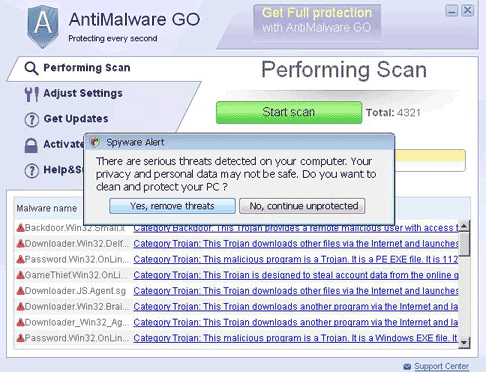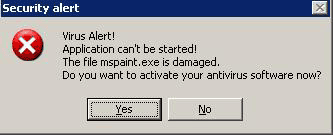TROJ_FAKEAV.ACE
Windows 2000, XP, Server 2003


Threat Type: Trojan
Destructiveness: No
Encrypted: Yes
In the wild: Yes
OVERVIEW
It opens TCP port 33440 and creates a completion port so that whenever a user tries to connect to any website, the request to that website will be intercepted and redirected to the proxy server on the local host. However, it allows the connection to continue for specific websites and certain porn sites to which it connects to. It will then send the browser data to its main server via HTTP GET request.
This Trojan may be dropped by other malware. It may be unknowingly downloaded by a user while visiting malicious websites.
It displays fake alerts that warn users of infection. It also displays fake scanning results of the affected system. It then asks for users to purchase it once scanning is completed. If users decide to purchase the rogue product, users are directed to a certain website asking for sensitive information, such as credit card numbers.
TECHNICAL DETAILS
Arrival Details
This Trojan may be dropped by other malware.
It may be unknowingly downloaded by a user while visiting malicious websites.
Installation
This Trojan drops the following copies of itself into the affected system:
- %User Temp%\{random name}\{random name}.exe
(Note: %User Temp% is the current user's Temp folder, which is usually C:\Documents and Settings\{user name}\Local Settings\Temp on Windows 2000, XP, and Server 2003.)
It creates the following folders:
- %User Temp%\{random name}
(Note: %User Temp% is the current user's Temp folder, which is usually C:\Documents and Settings\{user name}\Local Settings\Temp on Windows 2000, XP, and Server 2003.)
Autostart Technique
This Trojan adds the following registry entries to enable its automatic execution at every system startup:
HKEY_CURRENT_USER\Software\Microsoft\
Windows\CurrentVersion\Run
{random} = %User Temp%\{random name}\{random name}.exe
Other System Modifications
This Trojan adds the following registry entries as part of its installation routine:
HKEY_CURRENT_USER\Software\Microsoft\
Internet Explorer\PhishingFilter
EnabledV8 = 0
HKEY_CURRENT_USER\Software\Microsoft\
Internet Explorer\PhishingFilter
Enabled = 0
HKEY_CURRENT_USER\Software\Microsoft\
Internet Explorer\Download
RunInvalidSignatures = 1
HKEY_CURRENT_USER\Software\Microsoft\
Windows\CurrentVersion\Internet Settings
ProxyServer = http=127.0.0.1:33440
HKEY_CURRENT_USER\Software\Microsoft\
Windows\CurrentVersion\Internet Settings
ProxyOverride =
HKEY_CURRENT_USER\Software\Microsoft\
Windows\CurrentVersion\Policies\
Associations
LowRiskFileTypes = .exe
HKEY_CURRENT_USER\Software\Microsoft\
Windows\CurrentVersion\Policies\
Attachments
SaveZoneInformation = 1
It adds the following registry keys as part of its installation routine:
HKEY_CURRENT_USER\Software\mdnkso81qq2
It modifies the following registry entries:
HKEY_CURRENT_USER\Software\Microsoft\
Internet Explorer\Download
CheckExeSignatures = no
(Note: The default value data of the said registry entry is yes.)
HKEY_CURRENT_USER\Software\Microsoft\
Windows\CurrentVersion\Internet Settings
ProxyEnable = 1
(Note: The default value data of the said registry entry is 0.)
HKEY_LOCAL_MACHINE\SYSTEM\CurrentControlSet\
Hardware Profiles\0001\Software\
Microsoft\windows\CurrentVersion\
Internet Settings
ProxyEnable = 1
(Note: The default value data of the said registry entry is 0.)
HKEY_LOCAL_MACHINE\SYSTEM\CurrentControlSet\
Hardware Profiles\Current\Software\
Microsoft\windows\CurrentVersion\
Internet Settings
ProxyEnable = 1
(Note: The default value data of the said registry entry is 0.)
Other Details
This Trojan does the following:
- It connects to the following servers:
- {BLOCKED}spy.com
- {BLOCKED}spy.net
- After confirming a reply from the server, it then creates several threads. The first thread is to create the following pop-up in the system tray:

- It then proceeds to display its GUI, and other pop-up messages:

- It monitors newly created processes. If a new process is created, it prevents the user to using the executed file. Instead it displays a message that the file that is being executed by the user is infected and needs to be cleaned:

- It creates the following registry entries to redirect browser's request to a proxy server on the local host:
HKEY_CURRENT_USER\Software\Microsoft\Windows\CurrentVersion\Internet Settings
ProxyOverride = ""
ProxyServer = "http={BLOCKED}.{BLOCKED}.0.1:33440" - It opens TCP port 33440 and creates a completion port so that whenever a user tries to connect to any website, the request to that website will be intercepted and redirected to the proxy server on the local host. However, it allows the connection to continue for specific websites and certain porn sites to which it connects to. It will then send the browser data to its main server via HTTP GET request.
- It may connect to the following sites:
- www.{BLOCKED}a.com
- www.{BLOCKED}o.org
- www.{BLOCKED}o.com
- www.{BLOCKED}t.com
Rogue Antivirus Routine
This Trojan displays fake alerts that warn users of infection. It also displays fake scanning results of the affected system. It then asks for users to purchase it once scanning is completed. If users decide to purchase the rogue product, users are directed to a certain website asking for sensitive information, such as credit card numbers.
SOLUTION
Step 1
For Windows XP and Windows Server 2003 users, before doing any scans, please make sure you disable System Restore to allow full scanning of your computer.
Step 2
Scan your computer with your Trend Micro product and note files detected as TROJ_FAKEAV.ACE
Step 3
Restart in Safe Mode
Step 4
Delete this registry value
Important: Editing the Windows Registry incorrectly can lead to irreversible system malfunction. Please do this step only if you know how or you can ask assistance from your system administrator. Else, check this Microsoft article first before modifying your computer's registry.
- In HKEY_CURRENT_USER\Software\Microsoft\Internet Explorer\Download
- RunInvalidSignatures = 1
- RunInvalidSignatures = 1
- In HKEY_CURRENT_USER\Software\Microsoft\Windows\CurrentVersion\Internet Settings
- ProxyServer=http={BLOCKED}.{BLOCKED}.0.1:33440
- ProxyServer=http={BLOCKED}.{BLOCKED}.0.1:33440
- In HKEY_CURRENT_USER\Software\Microsoft\Windows\CurrentVersion\Internet Settings
- ProxyOverride="<local>"
- ProxyOverride="<local>"
- In HKEY_CURRENT_USER\Software\Microsoft\Windows\CurrentVersion\Run
- {random} = %User Temp%\{random name}\{random name}.exe
- {random} = %User Temp%\{random name}\{random name}.exe
Step 5
Delete this registry key
Important: Editing the Windows Registry incorrectly can lead to irreversible system malfunction. Please do this step only if you know how or you can ask assistance from your system administrator. Else, check this Microsoft article first before modifying your computer's registry. Before you could do this, you must restart in Safe Mode. For instructions on how to do this, you may refer to this page If the preceding step requires you to restart in safe mode, you may proceed to edit the system registry.
- In HKEY_CURRENT_USER\Software
- mdnkso81qq2
- mdnkso81qq2
- In HKEY_CURRENT_USER\Software\Microsoft\Internet Explorer
- PhishingFilter
- PhishingFilter
- In HKEY_CURRENT_USER\Software\Microsoft\Windows\CurrentVersion\Policies
- Associations
- Associations
- In HKEY_CURRENT_USER\Software\Microsoft\Windows\CurrentVersion\Policies
- Attachments
- Attachments
Step 6
Restore this modified registry value
Important: Editing the Windows Registry incorrectly can lead to irreversible system malfunction. Please do this step only if you know how or you can ask assistance from your system administrator. Else, check this Microsoft article first before modifying your computer's registry.
- In HKEY_CURRENT_USER\Software\Microsoft\Internet Explorer\Download
- From: CheckExeSignatures = noTo: CheckExeSignatures = yes
- From: CheckExeSignatures = noTo: CheckExeSignatures = yes
- In HKEY_CURRENT_USER\Software\Microsoft\Windows\CurrentVersion\Internet Settings
- From: ProxyEnable = 1
To: ProxyEnable = 0
- From: ProxyEnable = 1
- In HKEY_LOCAL_MACHINE\SYSTEM\CurrentControlSet\Hardware Profiles\0001\Software\Microsoft\windows\CurrentVersion\Internet Settings
- From: ProxyEnable = 1
To: ProxyEnable = 0
- From: ProxyEnable = 1
- In HKEY_LOCAL_MACHINESYSTEM\CurrentControlSet\Hardware Profiles\Current\Software\Microsoft\windows\CurrentVersion\Internet Settings
- From: ProxyEnable = 1
To: ProxyEnable = 1
- From: ProxyEnable = 1
Step 7
Search and delete this folder
- %User Temp%\{random name}
Step 8
Restart in normal mode and scan your computer with your Trend Micro product for files detected as TROJ_FAKEAV.ACE. If the detected files have already been cleaned, deleted, or quarantined by your Trend Micro product, no further step is required. You may opt to simply delete the quarantined files. Please check this Knowledge Base page for more information.
Did this description help? Tell us how we did.

